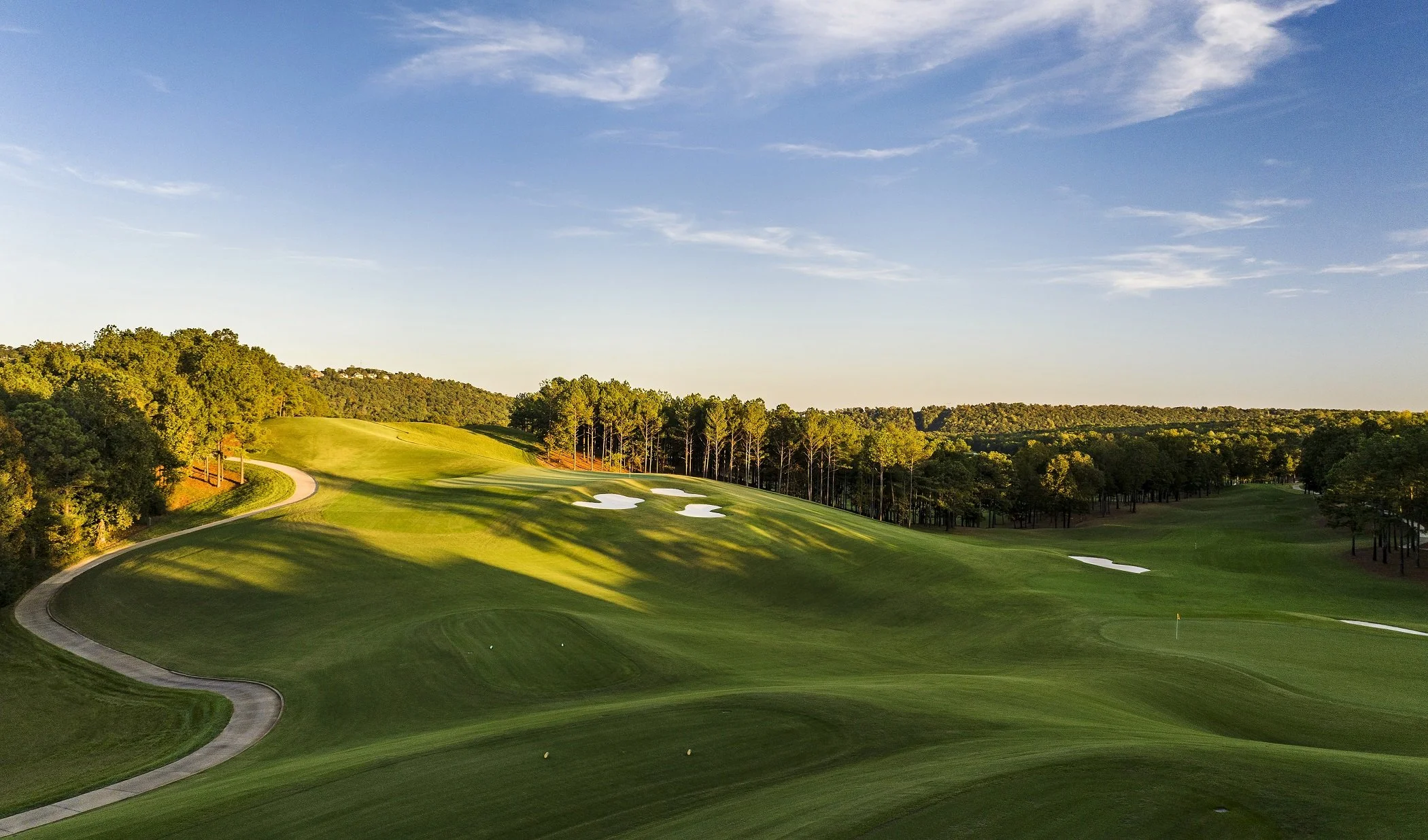Robert Trent Jones Trail in AL
Rebirth of the Ross Bridge course, one of the few in the U.S. to stretch beyond 8,000 yards
By Tony Dear
The Robert Trent Jones Trail which crisscrosses Alabama is a favorite travel destination of golfers from Michigan and the Midwest and connects almost two dozen courses inspired by one of America’s most prolific designers.
The Trail’s finest course is perhaps Ross Bridge outside Birmingham. In a horrible and unfortunate accident in September of 2022, however, it was forced to close when 14 of its greens perished following a regrettable misstep in the maintenance shed. A toxic mix of herbicide/fertilizer was mistakenly applied to the bentgrass surfaces instead of a green sand mix used for top-dressing. And though various measures, including injecting the turf/soil with charcoal to absorb the chemicals, were tried in an effort to limit the damage, the greens suffered an inevitable slow burn from which there was no return.
Joshua Cook, the course’s new Director of Maintenance who arrived three months after the incident, says it had a lasting effect on the maintenance crew.
“By the time I was taken on, the worst had blown over certainly, but it was still a sore talking point,” he says. “I honestly didn’t ask many questions about what happened because it didn’t really matter at that point. But it was easy to tell the team was pretty raw/sensitive about it.”
Silver Linings Found
Silver linings are hard to identify in such situations, but the true optimist could have pointed to Ross Bridge’s planned renovation, originally slated for 2025, being bought forward. Though not even 20 years of age, the original grass used for the course’s huge greens was set to be replaced with an ultradwarf bermuda, a class of sports turf that has seen considerable advancements in recent years. The unscheduled demise of the greens hastened the project which also included significant changes elsewhere on the course – tree removal, bunker removal/re-positioning, cart paths moved closer to fairways, tee boxes rebuilt, and drainage improved to 13 holes. The work began in earnest early in the Spring of 2023 and was completed in September, a couple of weeks before the course’s re-opening on October 13th.
Part of a media group that visited Ross Bridge in Mid-November, I was able to enjoy again a beautiful course I’d first visited in 2006 after word had got through to editors in England that a new layout in America’s Deep-South had broken the 8,000-yard barrier.
“Cartoonishly Long”
One enlisted me to find out what it was like to play so cartoonishly long a course, being sure to include details of all the lost balls and a five-hour round, at the end of which I staggered off the 18th green gasping for water. He wanted an untidy scorecard full of sevens and eights, and photographs of me hitting a driver on a Par 3 or a long-iron third shot to a Par 5.
Most of that did indeed happen, but the fact the Director of Golf, Chip Purser, joined me made the ordeal significantly more enjoyable than it might otherwise have been. Before we started, Purser told me that no one had been “stupid enough” to play all 18 back tees. He was smiling when he said it, though, which hinted at a sense of humor that would come in very useful at various points on the journey.
There are times when a baptism of fire can prove useful, advantageous even, but I’m not convinced struggling through Ross Bridge’s opening hole was terribly helpful. The 620 yards of heavily-sloping ground with water to the left was playing into a slight headwind whose affect was amplified by a distinct chill in the air. Only summer residents of California’s Death Valley or North Africa’s Sahara Desert would have described it as cold, but conditions certainly weren’t conducive to reaching Par 5s in two. I did manage to complete the hole with the same ball I’d started it with, but that’s all I’ll say about a hole that probably took 20 minutes to play.
The only possible way we were ever going to complete this round was in a cart. But even with the benefit of motorization, the distances we travelled seemed excessive. Remember that in 2006, a ‘Tiger-proofed’ Augusta National measured 7,445 yards. The US Open was played at 7,264-yard Winged Foot, the Open Championship at 7,258-yard Hoylake, and the PGA Championship over Medinah No. 3 Course’s 7,561 yards making it the longest course in major championship history to that point. All child’s play, however, as Purser and I would be taking on 8,160 yards from tees occasionally referred to as the ‘Marketing Tees’.
It was a long day and though my score wasn’t quite as bad as the editor had hoped for, it certainly wasn’t pretty for a one-time teaching pro still occasionally shooting in the low-70s on courses 1,500-1,750 yards shorter.
To be honest though, the scoring stopped somewhere early on the back-nine. By then, Purser and I had both abandoned the idea of posting a half-decent number and began experimenting with certain shots or playing two balls. It had become more about making whatever was left of the round enjoyable and less about finishing with a score – one we knew could potentially haunt us for years. Why play tees that are obviously too far back for you when you could have considerably more fun from further forward?
Chip was a significantly better golfer than me and did hit an approach shot on the Par 5 16th – a 270-yard 3-wood that pitched between a front bunker and a front pin before rolling to within a few feet of the hole – that I still remember vividly to this day almost 18 years later. But it was an isolated moment of brilliance in a round with precious few highlights. Had we continued scoring, I doubt Chip would have broken 80, and I was likely ten shots worse.
Purser is still the Director of Golf at Ross Bridge but, sadly, the timing wasn’t right in November for a repeat of the 2006 round. With an ailing back, I played from an altogether different set of tees and had a great time. Ross Bridge is probably my favorite course on the RTJ Trail, especially so after a very well-executed renovation and rebuild of the greens. The TifEagle surfaces are an attractive color, have great density, and roll very smoothly.
Joshua Cook has a good deal of experience with this turf having completed a couple of nursey trials as superintendent at Oak Tree National in Oklahoma and then working with TifEagle at Pensacola Country Club in Florida between 2018 and 2022. He was definitely encouraged by how the new greens at Ross Bridge were performing toward the end of 2023, but says there’s still room for improvement. “I liked where they were at considering how young they are,” he says. “But they still need to mature.”
Perhaps already tournament-worthy, Cook suspects the greens will reach their peak following summer 2024. After that, the focus will be on preventing the build-up of organic matter and thatch which can affect how well a green plays and have a negative impact on its lifespan.
Mistaking bags of herbicide for fertilizer can have dire consequences and affect a green’s lifespan too, of course. Barring a repeat of what happened in 2022, however, and with Joshua Cook in charge, I suspect Ross Bridge will continue to be the Trail’s crown jewel for another 25 years.




